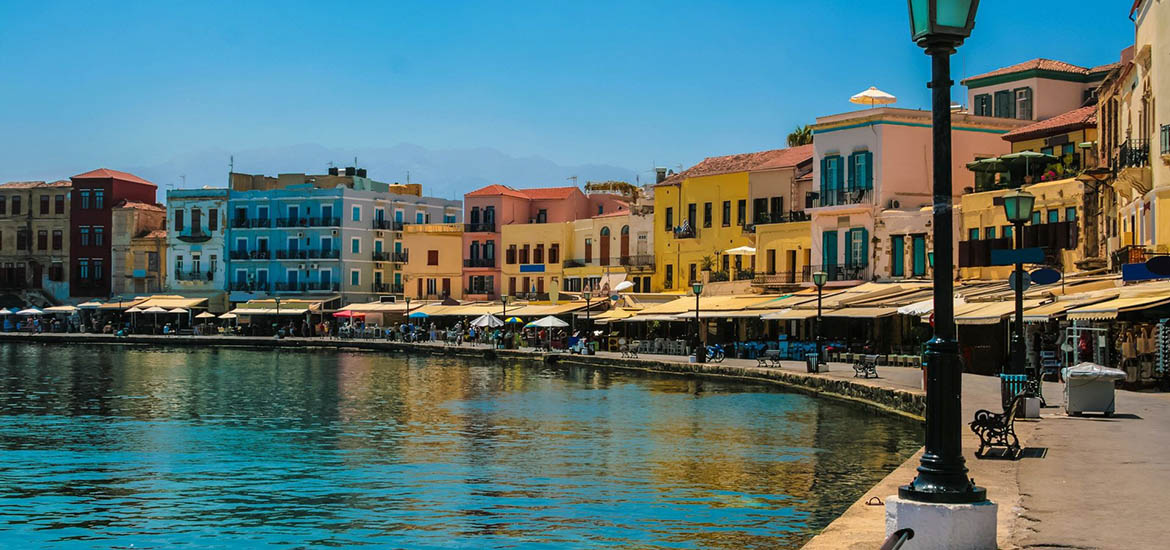TAKE A WALK ON THE WILD SIDE, OF CRETE'S HISTORY
DISCOVER THE OLD TOWN
The harbour comes into its own at night, when the lights from bars and restaurants reflect in the water and the animated crowds – locals as much as tourists – parade in a ritualistic volta of apparently perpetual motion.
There are stalls set up on the waterside, and buskers serenading the passers-by.
Walk straight on from Platia Sindrivani, and you chance upon the curious, domed profile of the Mosque of the Janissaries.
Built in 1645, the year Hania fell to the Turks and thus the oldest Ottoman building on the island, it has been well restored – apart from the jarring concrete dome – and was used to house the EOT office until further repairs meant they had to move to less-convenient Kriari street.
The buildings on the height above the mosque occupy the site of Kastelli. the oldest part of me city. Favoured from earliest times for its defensive qualities, this little hill takes its name from a fortress which originally dated from the Byzantine era.
Later it was the centre of me Venetian and of the Turkish towns, but very little survived a heavy bombardment during World War II.
Walking up Kanevaro street from the harbour square you’ll pass various remains, including – at the corner of Lithinon – the fenced-off site where a Minoan house is being excavated. Further up Lithinon, towards the top of the rise, are various Venetian doorways and inscriptions and, at the end of the street, a fine old arch-way. On me next corner, with Kandanoleon, is a larger area of excavation identified simply as “Minoan Kydonia”.

Neither of these digs is open to the public, though you can see a fair amount through me fence. Swedish archeologists excavating here have traced (he outline of a building engulfed by a violent fire about 1450BC, similar to mat which destroyed Knossos.
It was later rebuilt and. given its proximity to the mainland, may wen have been me focus of Mycenaean power on the island.
Among pottery finds here were some dating back to the Neolithic era, but the greatest prize uncovered was an archive of clay tablets bearing Minoan Linear A script , the first to be found so far west in Crete.
Back at the bottom of the hill me waterfront curis round to the right along Akti Tombazi, into the inner harbour, where pleasure boats, private yachts and small fishing vessels are moored. Much ot it, including file sixteenth-century.
Venetian arsenals and various traces of the ancient defensive bastions, has recently been refurbished, and in the evenings this is now a fashionable part of town.
Just on the corner past the Mosque of the Janissaries is the local handicraft cooperative (Mon-Sat 9.30am-10.30pm), with a permanent exhibition of goods for sale, though not everything is of particularly high qualify. In the line of old buildings facing the water beyond this, by the port police, are a couple of dancing bars.
Beyond all this are the Venetian arsenals, a cluster of restaurants and bars, and the modem Porto Veneziana hotel From here you can follow the sea wall round as far as the minaret-style lighthouse, where there’s a bar and an excellent view back over the city.
In the other direction from Platia Sindrivani is the outer harbour, with its broad promenade fronted by pavement restaurants and bars.



The hefty bastion at me far end houses Crete’s Naval Museum (Tues-Sun 10am-2pm), which is of Uttle interest unless you’re heavily into naval warfare or seashells (one small room is full of them) – It consists mainly of poorly labelled models and pictures of ships, diagrams of naval battles, and assorted memorabilia going back to the times of Classical Greek triremes.
Go through the main gate, however, into the compound of what is apparently a small naval garrison (open museum hours, but no need to pay me admission fee) and you can climb onto the seaward fortifications of the Firkas, as this part of the city defences is known.
Here the modem Greek flag was first raised on Crete – in 1913 – and there are more fine views.Carrying on round the outside of the Firkas, which has been well restored, you can peer through loopholes at the great vaulted chambers within. On the far side is the Hotel Xenia, itself raised up on part of the fortifications, and beyond this you can cut inland alongside the best-preserved stretch of the city walls.
Following the walls around on the inside is rather trickier, but worth a try for the chance to stumble on some of the most picturesque little alleyways and finest Venetian houses in Hania.
Keep your eyes open for details on the houses, such as old wooden balconies or stone coats of arms.
The arch of the Renieri Gate, at the bottom of Moschon, is particularly elegant There are also a number of good craft stores around here: a couple of the best, along with an expensive antiques store, are on Angelou just round from the Naval Museum entrance; several newer ones line Theotokopoulou, the delightfully old-fashioned street that runs behind.





